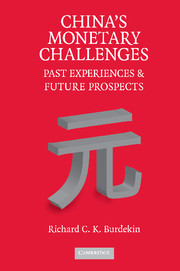Book contents
- Frontmatter
- Contents
- Preface
- Introduction: China Today and Lessons from the Past
- PART I CHINA'S EXCHANGE RATE REGIME AND MONETARY POLICY
- 1 The Renminbi–US Dollar Exchange Rate Controversy
- 2 China's Reserve Buildup and Global Imbalances
- 3 Combatting Inflation and Deflation
- 4 People's Bank of China Policymaking and External Pressures
- PART II THE IMPORTANCE OF INTERNATIONAL FACTORS, PAST AND PRESENT
- PART III THE PEOPLE'S REPUBLIC'S ROLE WITHIN GREATER CHINA AND ASIA
- 10 Conclusions and Future Prospects for the Renminbi
- References
- Author Index
- Subject Index
4 - People's Bank of China Policymaking and External Pressures
Published online by Cambridge University Press: 06 July 2010
- Frontmatter
- Contents
- Preface
- Introduction: China Today and Lessons from the Past
- PART I CHINA'S EXCHANGE RATE REGIME AND MONETARY POLICY
- 1 The Renminbi–US Dollar Exchange Rate Controversy
- 2 China's Reserve Buildup and Global Imbalances
- 3 Combatting Inflation and Deflation
- 4 People's Bank of China Policymaking and External Pressures
- PART II THE IMPORTANCE OF INTERNATIONAL FACTORS, PAST AND PRESENT
- PART III THE PEOPLE'S REPUBLIC'S ROLE WITHIN GREATER CHINA AND ASIA
- 10 Conclusions and Future Prospects for the Renminbi
- References
- Author Index
- Subject Index
Summary
In the first quarter of 2007,…the PBC [People's Bank of China] broadly sterilized the total liquidity from the RMB counterpart of foreign exchange assets supported with open market operations and reserve requirement policies in an effort to drain the liquidity in the banking system.
(People's Bank of China, 2007, p. 15)Introduction
Chapter 1 discussed the more flexible renminbi policy adopted in 2005, and the ongoing gradual appreciation following the initial 2.1% move on July 21, 2005. In addition to the external effects of this policy move, allowing some freedom from the fixed exchange rate constraint promised to increase the People's Bank of China's scope for effective monetary control. Ba Shusong, deputy director-general of the Finance Institute of the State Council's Development Research Center, for example, emphasized that the fixed exchange rate had “jeopardized” the independence of Chinese monetary policy. However, the People's Bank seems, in practice, to have been quite successful in containing the inflationary consequences of the continued buildup of foreign exchange reserves. Although the movement away from the old fixed exchange rate policy undoubtedly helped, the development of more market-orientated policy instruments also significantly benefited the People's Bank's monetary control.
This chapter begins with an overview of the changing techniques employed by the People's Bank over the years. The evolving role of open market operations is discussed in conjunction with the emergence of a liquid interbank bond market with a market-determined interest rate.
- Type
- Chapter
- Information
- China's Monetary ChallengesPast Experiences and Future Prospects, pp. 76 - 92Publisher: Cambridge University PressPrint publication year: 2008
- 1
- Cited by



